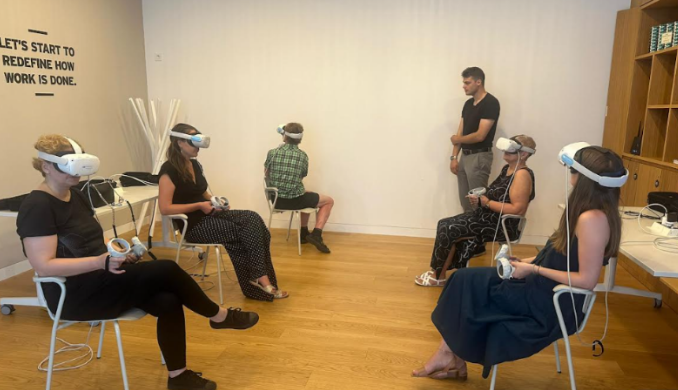- Strona główna
- Aktualności
- Newsletter 2
Newsletter 2
Co nowego?
Przestrzeń edukacyjna online dla nauczycieli języków obcych
Po pomyślnym uruchomieniu zestawu narzędzi XR (https://xrwomenproject.eu/pl/toolkit/), nasze międzynarodowe konsorcjum zwróciło uwagę na opracowanie pakietu szkoleniowego dla nauczycieli języków obcych. Pakiet ten ma na celu wyposażenie nauczycieli języków obcych w niezbędne
umiejętności i wiedzę, aby skutecznie wykorzystywać technologie XR z Oculusem w swoich
praktykach dydaktycznych dla określonej grupy docelowej (kobiety uczące się uchodźców i inne kobiety o mniejszych szansach). Z wielką przyjemnością informujemy, że ta internetowa przestrzeń edukacyjna została już ukończona we wszystkich mutacjach językowych!
Kurs składa się z czterech interaktywnych modułów nauczania, koncentrujących się na wykorzystaniu narzędzi XR, a w szczególności na integracji Oculus w edukacji językowej w celu zaspokojenia potrzeb kobiet o mniejszych szansach. Kurs obejmuje następujące obszary tematyczne:
- Wprowadzenie do XR – czym jest rozszerzona rzeczywistość i jakie są korzyści z wykorzystania XR w nauce języków obcych
- Metodologie/strategie nauczania mające na celu integrację podejść i technologii XR w nauce języków obcych
- Projektowanie lekcji opartych na wykorzystaniu XR dla kobiet z mniejszymi szansami, metody ewaluacji
- Konkretne narzędzia XR (Oculus) odpowiednie do użycia
ABY UZYSKAĆ DOSTĘP DO KURSU E-LEARNINGOWEGO, KONIECZNE JEST UTWORZENIE KONTA.
MOŻNA TO ZROBIĆ TUTAJ https://xrwomenproject.eu/pl/elearning/
Warsztaty pilotażowe
Aby przedstawić platformę e-learningową nauczycielom języków obcych i kobietom z mniejszymi szansami, każdy członek konsorcjum z powodzeniem przeprowadził warsztaty pilotażowe.
W Pradze zaprosiliśmy naszych uczestników do Spaces Smíchoff. Aby zapewnić uczestnikom „pełne doświadczenie” nauki języków za pośrednictwem XR, wypożyczyliśmy również kilka urządzeń Oculus. Dla niektórych uczestników było to pierwsze doświadczenie z wirtualną rzeczywistością i wszyscy dobrze się bawili.
Czego można się spodziewać?
Aby zaprezentować wszystkie wyniki projektu XR-WOMEN, zorganizujemy końcową konferencję XR- WOMEN. Wydarzenie odbędzie się 9 października 2024 r. w Pradze (miejsce do ustalenia). Zaproszone zostaną kobiety z mniejszymi szansami, nauczyciele języków, członkowie organizacji lub agencji wspierających uchodźców/migrantów, decydenci edukacyjni/politycy i inni. Każdy, kto chciałby dowiedzieć się więcej na temat uczenia się i nauczania języków obcych lub dowiedzieć się więcej na temat wykorzystania technologii XR w edukacji, będzie mile widziany na wydarzeniu. W programie znajdą się prezentacje, dyskusje na temat nauki języków, rozmowy z ekspertami na temat technologii XR i nie tylko!
https://www.puw.pl/pl/akademia-online
Bądź na bieżąco
Media społecznościowe partnerów projektowych
SEMwell facebook
CARDET facebook
University of the Agean facebook
Academy of Humanities and Economics in Lodz facebook
Swiss Federation for Adult Learning LinkedIn
Kontakt:


Numer projektu: 2022-1-CY01-KA220-ADU-000086774
